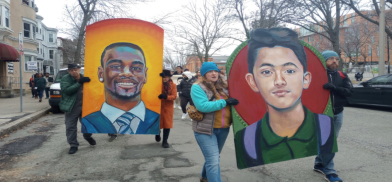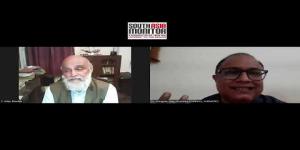Bangladeshi-origin student's death: South Asian diaspora seeks justice and protection from racist policing
The relationship between South Asians and policing reflects both the racist structure of US policing and internal differences among South Asians in their experiences with policing. South Asians in the US are stratified by caste, class, religion, language, nationality, ethnicity, and documentation status.

On 4 July, as many Americans celebrated the country’s independence, the family and friends of a Bangladeshi-origin student Arif Sayed Faisal in the Boston area commemorated six months since the police shooting that took his life.
The officer who fired the fatal shot is on paid administrative leave. Others involved are still on duty.
A broad coalition of nonprofits, volunteer collectives and social justice parties convening under the Justice for Faisal banner has been protesting regularly since Faisal’s death on 4 January 2023. He was a student at the University of Massachusetts Boston, home for the winter break.
Preventable tragedy
Faisal was killed after a 911 call about a man jumping from an apartment window with a knife and self-harming. The Cambridge police officers who arrived pursued Faisal, initially firing sponge bullets, then lethal shots, claiming failed de-escalation.
The tragedy has catalysed important conversations about mental health, a stigmatised topic among South Asian-origin households.
A powerful symbolic action by the #JusticeForFaisal coalition was a march on 29 January to the Mystic Mural, a community art project highlighting environmental issues that Faisal had contributed to as a student at Somerville High School.
“Victims of police killings are not just another statistic. It is important to remember their humanity,” says Suhail Purkar, an organiser with Party for Socialism and Liberation Boston, and Boston South Asian Coalition.
The movement in Cambridge calling for broader police accountability may signify a new moment of anti-carceral organising, activism and coalition-building, bringing together the Southasian diaspora with local activists fighting systemic racism and police brutality.
The groups involved include the Bangladeshi Association of New England, Boston South Asian Coalition, Safe Schools Somerville, and Party for Socialism and Liberation.
On 12 May, a city councillor filed a policy order, joining protestors’ demands that the names of the officers be released, But the state says their names cannot be released because of a judge order until an inquest is completed.
Faisal is not the first youth of colour shot dead while undergoing a mental-health crisis in the United States. There is in fact a long history of criminalising people with mental-health emergencies. Between 2015-2018, almost a quarter of those killed by the police had a known mental illness.
A database compiled by The Washington Post suggests there have been over 1,700 cases of mental illness-related police shootings since 2015. Only a handful of such cases make it to public notice. Hope Coleman, the mother of Terrence Coleman had called 911 in 2016 to seek support for her son who was having a schizophrenic episode. She has been attending #JusticeforFaisal rallies where she shares her own story, re-living the trauma of the Boston police shooting and killing her son.
“Had I not called 911, my baby would be alive,” she says.
In 2020, Boston police shot and killed Juston Root after wounding him. The 41-year old was lying “defenceless, on the ground, semi-comatose, and bleeding profusely. Juston was not brandishing a firearm nor did he have any firearm in his possession," according to a statement from the lawsuit filed by his family against the city of Boston.
He was suffering from schizoaffective disorder and had been carrying an unloaded plastic BB gun.
Despite calls to action, little has changed. The MappingPoliceViolence.org portal documents that U.S. police shootings claim nearly 1200 people every year.
Media portrayal
Activist Suhail Purkar points to the “dehumanising difference” with which the media tend to portray Faisal compared to the policemen who killed him. This feeds the misperception of Faisal as an ‘armed man’, prompting some to justify his killing.
CBS News Boston ran the headline “Man armed with a machete shot and killed by the police” without mentioning his mental-health crisis or that he was inflicting self-harm. Another media report notes that the police official who shot Faisal had seven years of experience on the force, with no complaints.
Activists say that Cambridge police set the narrative because they do not wear body cameras. Of the 1,717 cases of police shooting mentally ill people, only in 17.8% (306) of the cases, the police had body cameras, reports The Washington Post.
South Asians and policing
The relationship between South Asians and policing reflects both the racist structure of US policing and internal differences among South Asians in their experiences with policing. South Asians in the US are stratified by caste, class, religion, language, nationality, ethnicity, and documentation status.
The effects of and responses to policing follow similar lines. Some South Asian individuals and communities, similar to the public housing block that Faisal lived in, are more policed than others.
Last November, police in Austin, Texas, killed Rajan Moonesinghe, a Sri Lankan American entrepreneur. The police were responding to a report from Moonesinghe of a possible burglary at his home. In a tragic turn of events, the police mistook him for the burglar and shot him before he had the chance to lower his gun.
Southasians are directly affected by the policing of poorer neighbourhoods, associations with Islamophobia, lack of cultural awareness, language barriers, and perceptions of security threat, including through associations with Blackness.
In 2015, the Alabama police acting on a report about a “skinny Black man” apprehended Sureshbhai Patel, a 57-year-old Indian man on a family visit walking around the neighbourhood. Unable to understand what the police were saying, he did not follow their commands.
“My South Asian friend gets regularly stopped at traffic lights because the police assume he is Black”, says Suhail Purkar.
Police reforms
Not surprisingly, support for police reform is growing among South Asian Americans. A 2017 NPR report suggests that 44 per cent of Bangladeshi Americans, 50 per cent of Pakistani Americans and 49 per cent of Asian Indians did not believe that the police treat all racial and ethnic groups equally. In 2020, among Asian Indians, 51per cent strongly agree and 24 per cent somewhat agree that local governments should reallocate police funds towards welfare programs, according to AAPI data.
“There is still need for more political education,” says Sharmin Hossain, a Bangladeshi-American artist and former Political Director at Equality Labs, a US-based Dalit civil-rights organisation.
She says that conservatives use South Asian Americans and Muslim Americans “as a good wedge for conservative politics”, including through “anti-immigrant views that are responsible for policing of other South Asians”.
Hossain notes that a primary way South Asians experience policing is through immigration, referring to police apprehending as many as 63,927 Indians at US borders in 2022. Today, many among the older generation of South Asians no longer see the police in America as benevolent.
Community bridges
There is clearly a greater need for consciousness-raising among the South Asian diaspora, say Cambridge community organisers. Part of the work is “to reflect upon anti-Blackness in our own communities so that our aunties and uncles are not the ones calling the cops on Black folks and on each other,” says one activist, asking not to be named.
We need to understand that “being a good immigrant does not protect us from racist police violence. The focus should be on showing up and joining the Black, Latinx and indigenous folks doing this work for decades,” they add.
The Justice For Faisal movement is the Justice for Tyre Nichols movement is the Justice for Terence Coleman movement, say organisers. These unnecessary deaths are due to continued bad policy choices informed by racist structures. Political will can make all the difference.
Organisers also highlight the need to connect the dots transnationally, as people protesting Faisal’s killing in Dhaka have been doing, and to recognise how policing disproportionately affects some communities even “back home”.
In America, ongoing discussions among the community are highlighting the imperial and military connections of US civilian policing, such as the 1033 program, which transfers Defense Department military equipment to local, state and federal law enforcement.
#JusticeforFaisal Demands
The community continues to demand the release of names of the police officials who shot or were involved in Faisal’s murder, release of the unredacted police report and the firing, charging and prosecuting of the officials involved.
“The only reason it would matter if the police official is a South Asian/Black person is to reiterate that bad policing is not an issue of application or representation,” says Payal, an activist who goes by one name. “It’s systemic.”
Cambridge police prides itself as being one of the best-trained forces in interpersonal dynamics. People are thus divided on the question of more police training or changing the nature of training, including training not to shoot at centre mass. In June, the City council moved to vote down without discussion a proposal to turn the Police Review and Accountability Board into an elected body.
The #JusticeForFaisal community also makes broader structural demands: disarm and demilitarise the police (including dismantling the 1033 program), fully fund an alternative emergency response system separate from the police, and reallocate the budget into community safety and support.
Small wins, ways forward
The activism and solidarity of Black and Brown communities in Cambridge have contributed to Cambridge City Manager Yi-An Huang’s announcement that the Cambridge police will use body cameras.
Proposals on ways forward include Cambridge Holistic Emergency Alternative Response Team (HEART), an alternative response system formed after demands to delink police from mental health emergency responses. Elsewhere, non-carceral response teams such as Crisis Assistance Helping Out on the Streets (CAHOOTS) are working with local communities.
These initiatives, centering unarmed but trained civilian crisis response to 911 calls, represent a way forward. However, “such initiatives only go halfway if they continue to operate as nonprofits and are not built into the public health system,” cautions Purkar.
Currently, HEART is a subcontractor with the Department of Public Health, substantially underfunded at less than $2 million. In contrast, Cambridge Police’s 2023 budget is to increase by 7 per cent from $68.7 million to $73.5 million. Organisers note that under current regulations, situations like Faisal’s would be categorised as violent and still go to the police.
“At the very minimum, mental health emergency care has to be completely de-linked from incarceration,” insists Payal, who works in the healthcare system.
What emerges in these debates about the effectiveness and better alternatives is a consensus across the South Asian diaspora against racist policing and an emerging allyship with the fight against systemic racism in America.
(The author is a Ph.D. student in sociology at University of Massachusetts Amherst. She can be reached at upasanakohuwa@gmail.com. By special arrangement with Sapan News )










Post a Comment